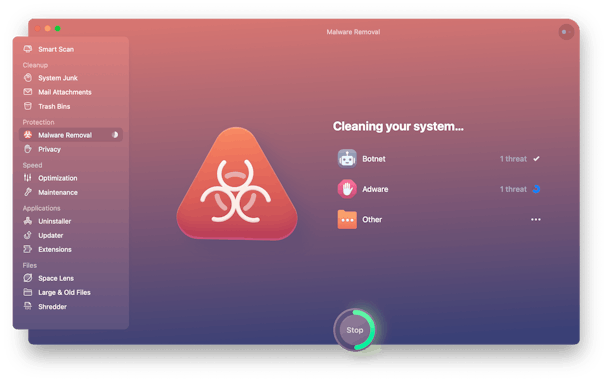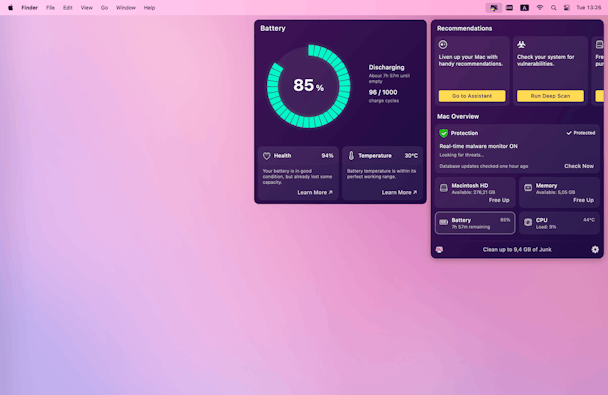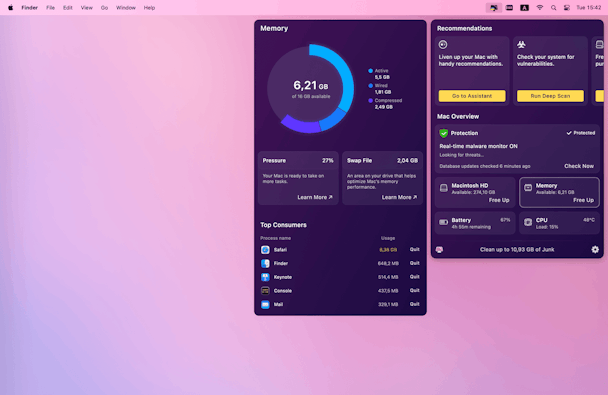A beauty of a MacBook or any other laptop is its portability. You can
unplug it and use whenever and wherever you want. Of course, it only
makes sense if it holds the charge. That’s why it can be a nightmare
when your laptop is not charging hence killing its portability factor.
In this article, we’ll walk you through the step-by-step process to
fix your MacBook that’s not charging. But before we start, let’s look at
a few possible reasons why your laptop battery won’t charge.

Why my Mac won't charge?
Possible reasons why your computer won’t charge:
- Broken connections
- Incorrect settings
- Hardware problems
- Battery critical condition
- Overheating

Can certain apps affect battery health?
In short, the answer is yes. According to security researcher, Charlie Miller, “malicious
software may be exploited in various ways, from just causing the
battery to stop functioning to auto-installing malware.” The
"backdoor" applications may disguise themselves as alerts to “update
your Flash player” or imitate harmless Chrome extensions. If you are
unsure about downloading such things in the past, you need to run an
anti-malware check. Chances are, your battery will come to life.
Many users on Apple forums recommend using CleanMyMac X as it deals with macOS-specific viruses. This app developed by MacPaw is notarized by Apple, so you are safe downloading it.
Here is the link to get a free edition.

When you run CleanMyMac X, click the Malware Removal tab. This should reveal if any app has highjacked your battery.
How to troubleshoot a MacBook that’s not charging
Here are 5 ways to fix your MacBook, MacBook Air or MacBook Pro not charging.
Method 1: Physically inspect hardware
Before you look any further, you need to check the basics. If your
MacBook Pro battery is not charging, verify the power cable. Inspect
every inch of the cable and look for broken spots or any dark stains on
its surface. If you find any damage, there is a chance it’s causing the
problem.
The next thing you should do is to verify the ports for any foreign
objects or debris. Dust can build up in the charging port blocking the
connection, so if you find something, use a wooden object to remove it
(you can use a toothpick).
Check whether you are plugged in into the wall socket. Make sure it
is turned on or try using a different socket. We know this sounds a bit
basic but it’s always better to double check.
⚠ CAUTION
To prevent electric shock and other dangerous accidents,
be careful when working with wiring and power tools. Never leave
electrical appliances somewhere they can easily fall into the water.
Always be cautious for your own safety.
Method 2: Reboot your MacBook
Just like apps on your MacBook can get frozen, so can the hardware
that controls the charging of your notebook. That’s why when your
MacBook won’t charge, try to restart it. A simple reboot can reset the
hardware and fix the problem.
- Click on Apple logo in top left corner of your screen.
- Click Restart.
- Wait for the reboot and then try charging your Mac again.
As simple as that! Now you know what to do before asking yourself, “Why isn’t my laptop charging?”

Method 3: Check your battery health
The MacBook battery may wear out faster than expected if you use it
intensively. You should always monitor its status; otherwise, there’s a
risk of having a non-working notebook at the most inappropriate time.
Checking your battery health is especially relevant when the battery
doesn’t charge even with a cable.
To view the state of the battery health, press and hold Option (Alt)
key and click the icon of the battery in the Menu Bar. The advanced
options of the menu will appear. There are two states your battery may
be in:
- Normal — Your battery is functioning well.
- Service recommended — The battery works fine but holds the charge less than it did before. It should be replaced soon.
A free tool to check the battery👇
There’s a nice tool you can use to check your battery’s condition.
It’s free since it’s available in a free version of CleanMyMac X. What
it does is calculate the cycle count of your battery, which is a more
realistic indicator of its health.
Note: A typical MacBook battery is designed to withstand 1000 charge-discharge cycles.
Download a free version of CleanMyMac X.
In the app, click on the little iMac icon in the upper Menu bar.

Now, inspect the tab for Battery.


Method 4: Reset the SMC
The System Management Controller (SMC) is responsible for the battery
management and its status indicator lights. Therefore, if your Mac
battery is not charging, resetting the SMC may help.
Note that the process of resetting the SMC for MacBooks with a
removable battery and a non-removable battery is quite different. That’s
why first you have to determine whether your battery is removable.
Mac notebooks that have non-removable batteries include MacBook Pro
(mid-2009 through 2017), MacBook Air (2017 and earlier), and all MacBook
models (except the 13-inch MacBook introduced in mid-2009).
If a battery is non-removable:
- Shut down your MacBook.
- Press Shift-Control-Option and a power button at the same time and hold for 10 seconds.
- Release the keys.
- Press the power button to turn on your Mac.
RESET THE SMC

Method 5: Cool your MacBook
It may be surprising but the reason of your MacBook battery not
charging may be as simple as overheating. If the thermal sensors within
your laptop detect a drastic rise in temperature, they block out the
access to the battery as a safety measure.
What can you do if your MacBook is hot to the touch? Simply turn it
off and let it be for some time, or place a fan near your Mac to cool it
down right away. If you work outside, move into the shade — direct
sunlight can cause your Mac getting hot.
Method 6. Check for battery-draining apps
Another issue is battery-draining apps. It has been noted that some
programs are extremely taxing on the battery. There’s a simple way to
check it using the tool we’ve mentioned above, CleanMyMac X. It has a
system health monitor in the upper bar of your Mac.
When you click on it, you will see the apps that drain your battery far too much:

You may need this tool to do further maintenance on your Mac. Download its free version here, from the official site.
If all troubleshooting methods fail, consider taking your MacBook to
the Apple Store or a certified Apple repair center. Every laptop has its
own quirks, and at this point, it’s better to ask a licensed
professional to help. More than likely, your MacBook will need a unique
fix. To avoid those unpleasant “Why won’t my laptop charge?” surprise,
also check our comprehensive guide on “How to increase Mac battery life.” Take care of your battery health!







